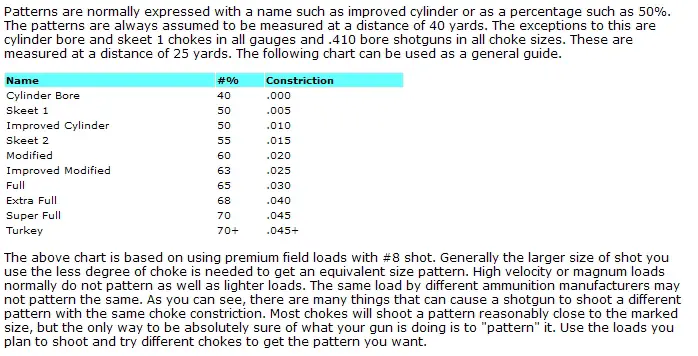


Controlling Shotshell Pattern Diameter
Another
way to view the notion of “choke” is controlling the diameter
of your shot cloud down range. Choke markings on tubes and barrels don't
mean anything by themselves; more often than not factory choke tubes to
not perform as marked. Like it or not, there is only one universal way
to grade chokes: pattern percentage in a 30 inch circle. Chokes designated
as Improved Cylinder or tighter are graded as percentage of pellets originally
loaded into the shell that land in a 30 inch diameter circle at 40 yards.
Of course, we don't always shoot at targets exactly 40 yards away exactly the same height as our muzzles, so the 40 yard comparison loses meaning contingent on what specific distances we take our targets at. You might think that a 30 inch circle is a lot of real estate. It is, at 706 square inches. Yet, it takes a lot more choke effect to contain our entire pattern inside that 706 square inches than you might think. This animation gives you the general idea, for both 1-1/8 oz. lead #7-1/2 loads at ten yard increments from 30 to 60 yards. The same sequence is repeated for the far lower pellet count load of 1-1/4 oz. of #5 lead. Note that the smaller, inner circle is the "30 inch" traditional pattern grading area.
Warren Johnson, with the release of his “Choke Chooser,” made it easy to see how small in diameter effective patterns actually were, particularly for angled clay targets. As the Volcano of Knowledge, Bruce Buck once said: “If you can’t hit the bird, it really doesn’t matter what choke and shell you miss it with.” John Harradine, in CARTRIDGE PATTERNING WE NEED TO DO IT - AND BETTER!, a 2002 article for the BASC, noted: “Statistically, the necessary one or two pellet strikes on the bird’s vital organs, which Roster has shown are required to ensure a quick kill, will occur in 19 out of 20 shots, and that in order to ensure those strikes, each bird must be struck, with some 6 or 7 pellets overall.”
In American Skeet and 27 yard handicap trap, the type of choke used is fairly well established. Not so for wild birds, where ranges change everything in a big hurry. No matter how good the choke, your choke cannot make your shot harder, more spherical, or magically add buffer. As a result, the choke that is the most effective cannot be answered until the specific shotshell is defined as well as the maximum range you intend to take a gamebird at.
Sir Ralph William Frankland-Payne-Gallwey, 3rd Baronet (1848 - 1916) had his own views on chokes and patterns, writing:
"A cylinder 12-bore gun should, if it is properly bored, place 130 pellets of shot on the 30 in. circle at 40 yards with a charge of 1-1/8oz. of No. 6 shot, containing 304 pellets, or 270 to the ounce. A fullchoke should place 200 to 220, and a modified choke 150 to 160: and it should be borne in mind that a constant regularity of pattern, and even distribution of the shot all over the 30 in. circle, is a sine qua non in the shooting of a good gun." Though known as an engineer, historian, ballistics expert, and artist in his time, he apparently didn't have much of a grasp of chokes, stating "Lord de Grey uses a full-choke, and Lord Walsingham a gun without any choke; yet both these gentlemen kill their game in brilliant style, near or far. At the same time, this is no proof that the average marksman would drop his game with a full-choke as well as he would with a cylinder; though it does show him what he might do with a cylinder if he had the gift of using it with sufficient accuracy."
It is hard to say what shot size Sir Ralph was referring to, as #6 English is about 291 pellets to the ounce. Nevertheless, his "cylinder" threw about a 43% pattern and his "modified" threw 52% at the upper end, and his "full" threw about 72% at the better, 220 pellet level. It doesn't work with currently accepted pattern levels such as the basics published by George Trulock.

Sir
Ralph William Frankland-Payne-Gallwey's "Modified" was no better
than today's I.C., yet his "Full" was a Turkey choke. Lord de
Grey was "brilliant" with his turkey choke, yet Lord Walsingham
apparently was equally brilliant, near and far, with no choke at all.
We've come a very long ways since the days of Sir Ralph, but in one area
not much has changed. Despite the pleading of John Harradine, we really
can't be bothered to pattern our shotguns. If we did, most folks wouldn't
be using the shells or the chokes that they currently are.
Copyright 2012 by Randy Wakeman. All Rights Reserved.

Custom Search



